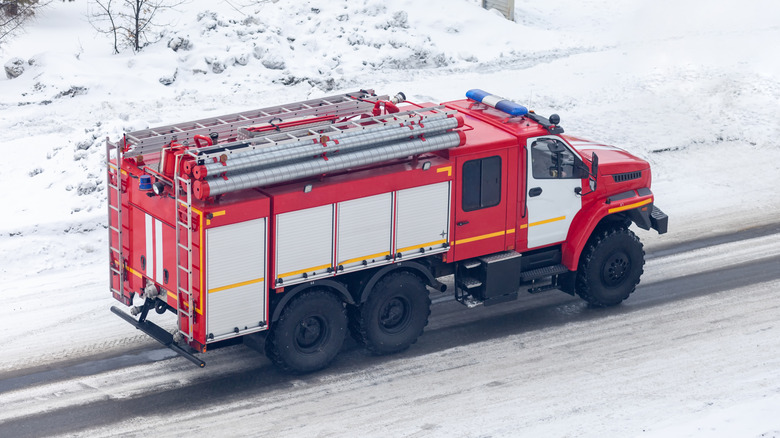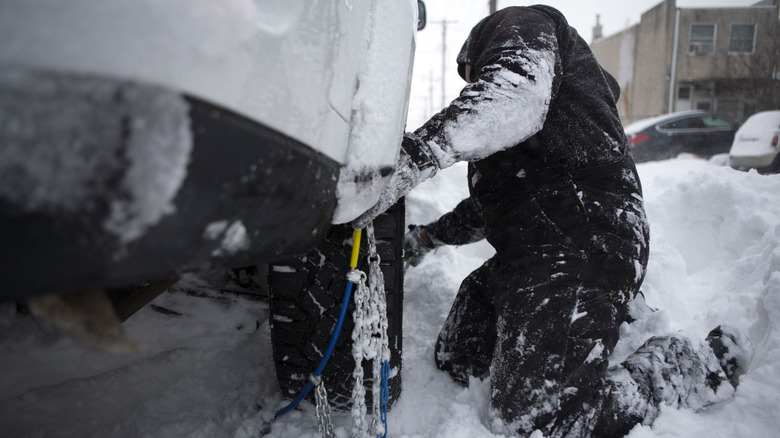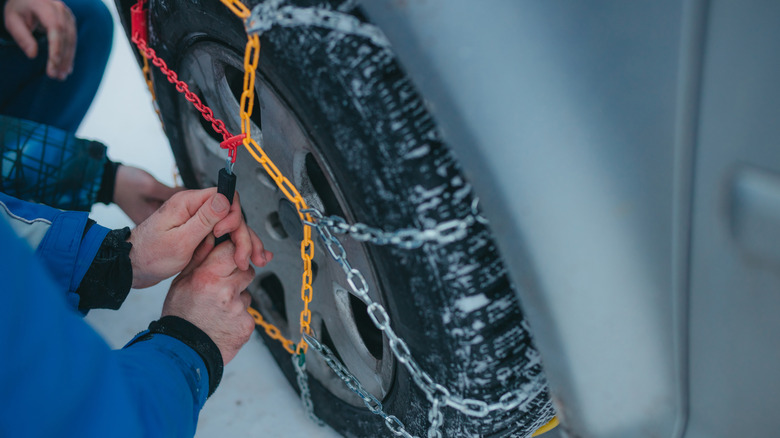What Are The Chains Beneath Fire Trucks & Ambulances For?
Putting tire chains on your car manually can be a frustrating and time-consuming process, especially since it's usually done in very cold weather. It can also be dangerous, with the Insurance Institute for Highway Safety (IIHS) estimating that about 300 pedestrians lose their lives every year in the U.S. while attending to stopped vehicles on the side of the road. Instead of manually installing tire chains in icy weather, many vehicles are equipped with systems that can deploy traction at the touch of a button in icy conditions.
Some personal vehicles can use automatic tire chains, but most use traditional snow chains, unless you've bought studded tires to gain traction on icy surfaces. Automatic systems are instead typically installed on emergency vehicles, school buses, or other large vehicles like delivery trucks. They are designed to withstand harsh environmental conditions in which they operate while keeping these vehicles safely on the roads and on schedule even in the worst conditions. They are permanently mounted to the underside of the vehicle, require some maintenance, and cannot be left behind in the same way traditional tire chains can be if they slip off when not fitted properly.
Automatic tire chains are convenient but manual ones work better in some conditions
Even though automatic tire chains do offer many advantages over traditional setups, there are still instances where heavy-duty chains or other tire chain alternatives can help get your car through snow and icy conditions better. For example, in extremely deep snow, traditional chains are going to perform better because they cover the entire circumference of the tire and maintain traction more consistently. It's a similar story with off-roading because its best to have your tires fully wrapped on surfaces that vary drastically, as it enables more consistent traction.
Automatic tire chains also require a higher upfront investment because they need to be installed permanently with the use of pneumatic components to engage them. This means they also often require maintenance and need to be used at least a couple of time a month to keep the system working properly. Many vehicles just don't have the space for automatic chains to be installed in the first place, which is partly why these are typically only found on larger vehicles like trucks and ambulances. That being said, compatibility issues are mostly non-existent with traditional chains, which can be purchased in lots of different sizes and shapes to fit your vehicle.
Automatic tire chains can be costly but are long-lasting if used properly
Automatic tire chain costs can vary greatly. For example, one pair stripped from a smaller sized school bus sold on Industrial Scrap Corporation costs around $450. Onspot, which manufactures automatic tire chains, estimates that a full system will usually cost around $2,500. It should be noted that the process of installing automatic tire chains requires mounting them under the rear axle, which will likely need to be done professionally and can add upfront costs. On the other hand, a more traditional tire chain set is likely to set you back anywhere between $50 and $300.
When it comes to longevity, Onspot notes that automatic tire chains can last for up to 2,000 miles of engaged use with proper maintenance. Tire chains in general aren't designed for use on bare roads without snow or ice as that can significantly shorten their lifespan. Driving quickly with tire chains engaged could also prematurely wear them out, which is why some manufacturers impose speed limits on their systems.


